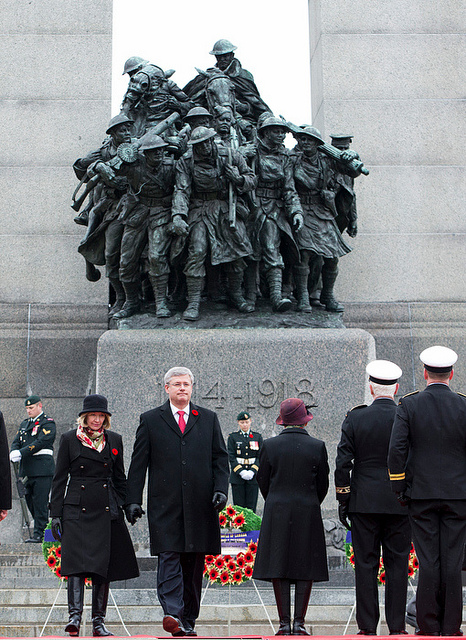Stephen Harper left the Beijing APEC (Asia Pacific Economic Co-operation) conference early. Following the official photo op, Minister Stephen Harper hopped back across the Pacific to Canada for Remembrance Day ceremonies at the Cenotaph (rebranded as the War Memorial) in Ottawa, and more photo ops.
The APEC meetings took place with world tensions building in the Pacific region. There is bad blood between Russia and the West over Ukraine; relations between China and Japan have deteriorated: and the U.S. “pivot” towards China causes deep concern in Beijing.
To address differences, Putin and Obama were holding private talks at APEC, as were the Chinese President and Japanese Premier Abe. Other APEC countries were taking and offering counsel, assessing each situation for its potential to explode, and looking for ways to reduce heated conflicts.
Why would a Canadian prime minister not want to do the same? By leaving early Stephen Harper gave up opportunities to address issues of world security directly with other leaders. Instead of building personal contacts, sorting out avenues for international co-operation, and looking for shifts in national attitudes that could signal opportunities for diplomatic initiatives, he flew away.
Ever on the lookout to show his economic credentials, by coming back early Harper missed sessions with leaders of the three largest economies in the world (U.S., China, Japan) which along with other APEC nations (like Russia) represent 50 per cent of world GDP.
After the November 11 ceremony, Harper will turn right around and hop back across the Pacific towards New Zealand for an official visit, and then on to Brisbane for the G20 Summit (November 15-16) where he can be part of yet another photo op.
Turning a two-way trip across the Pacific into a four-way trip is part of the Harper plan to build support for his government by linking it to respect for the military, and bravery in action. On this Remembrance Day, Conservatives hope Canadians will forget the UN peace-making image associated with the Liberals, New Democrats, and once proud Progressive Conservatives.
The Harper government wants the tribute at the eleventh hour, of the eleventh day, of the eleventh month to be a celebration of the Canadian Forces participating in a war on terrorism.
Gloating over military prowess dishonours the ceremony. Remembrance Day is for the living to honour the memory of those Canadians who died so that Canadians can live at peace. The glorification of the military at war is not what people gather to remember.
Similar remembrance ceremonies exist in countries around the world for a reason. War is an obvious insanity when other means exist to settle serious differences; diplomacy for example, the United Nations, and summit gatherings like the APEC conference.
Harper came back to Canada for a Remembrance Day photo op because he has identified the “war on terror” as a winning issue. Showing himself at the national cenotaph so soon after the murder of a Canadian soldier at the site was a way he could underscore his distance from his rivals Tom Mulcair and Justin Trudeau.
Harper hopes fear of terrorists strikes at home will drive Canadians to support his government in taking military action against Islamist forces abroad. For sure playing on those fears builds Islamophobia in Canada. Whether brandishing terrorist threats helps Harper wins re-election remains to be seen.
Mulcair has quite properly said that the act of one killer does not constitute proof of an international terrorist conspiracy directed at Canada. Justin Trudeau has questioned the military strategy behind sending CF-18 fighters to bomb Iraq in the name of the war on terror.
Canadian veterans themselves have decided to boycott all photo ops with Conservatives until the absence of serious medical treatment for veterans is addressed properly. Appallingly, the number of suicides of Canadian Afghan vets now exceeds the total of Canadian Forces soldiers who died in the war.
The meaningful celebrations of the 1919 armistice and the remembering of the supreme sacrifice of the Canadian war dead are solemn state occasions. Appropriately, the Governor-General plays the lead role; the presence of the prime minister is not required. While he may be the head of government, Stephen Harper is not the head of state. In the absence of the Queen (almost always) the Governor-General serves in that capacity.
Attaching himself to military occasions fits with Harper’s adopted vision of modern Canada as forged in the First World War at Vimy Ridge where four Canadian divisions fighting together distinguished themselves in combat. In fact, the recognition of Canadian independence dates from the insistence by Prime Minister Sir Robert Borden that Canada sign the 1919 Peace Accord separately.
The tower above the Parliament Building was called the Peace Tower in commemoration of the end of the First World War, not the war tower.
Within the peace movement, there has been an understandable reluctance to transform the day we remember the dead in foreign wars into a call for arms reduction, and to end combat missions. Trailing in opinion polls, Stephen Harper showed no such sensitivity to keeping means and ends separate.
To push a political advantage, the prime minister was prepared to leave a meeting of world leaders early, in order to use the 11th of November for partisan political purposes.
Duncan Cameron is the president of rabble.ca and writes a weekly column on politics and current affairs.
Photo: pmwebphotos/flickr



